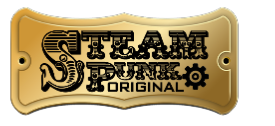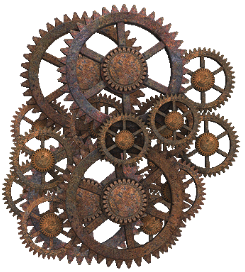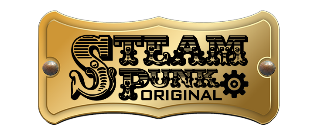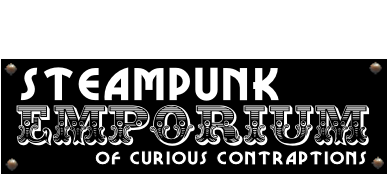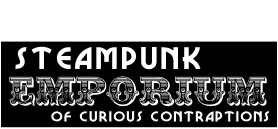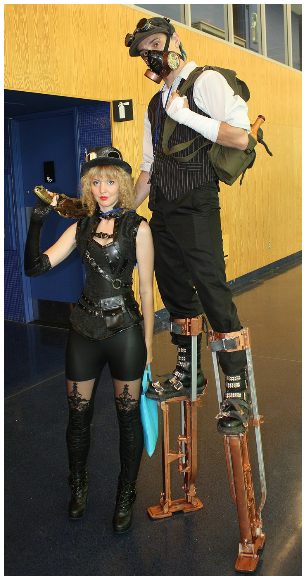Steampunk Fashion & Literature
SteamPunk Fashion
Steampunk fashion has no set guidelines but tends to synthesize modern styles with influences from the Victorian era. This may include bustles, corsets, gowns, and petticoats; suits with waistcoats, coats, top hats, tailcoats and spats; or military-inspired garments. Steampunk influenced outfits are usually accented with several technological and "period" accessories: timepieces, parasols, flying/driving goggles, and ray guns. Modern accessories like cell phones or music players can be found in steampunk outfits, after being modified to give them the appearance of Victorian-made objects. Post-apocalyptic elements, such as gas masks, ragged clothing and tribal motifs, can also be included. Aspects of steampunk fashion have been anticipated by mainstream high fashion, the Lolita fashion and aristocrat styles, neo-Victorianism, and the romantic goth subculture.
In 2005, Kate Lambert, known as "Kato", founded the first steampunk clothing company, "Steampunk Couture", mixing Victorian and post-apocalyptic influences. In 2013, IBM predicted, based on an analysis of more than a half million public posts on message boards, blogs, social media sites and news sources, "that 'steampunk,' a subgenre inspired by the clothing, technology and social mores of Victorian society, will be a major trend to bubble up and take hold of the retail industry". Indeed, high fashion lines such as Prada, Dolce & Gabbana, Versace, Chanel and Christian Dior had already been introducing steampunk styles on the fashion runways. And in episode 7 of Lifetime's "Project Runway: Under the Gunn" reality series, contestants were challenged to create avant-garde "steampunk chic" looks. America's Next Top Model tackled Steampunk fashion in a 2012 episode where models competed in a Steampunk themed photo shoot, posing in front of a steam train while holding a live owl.
SteamPunk Literature
The educational book, Elementary BASIC - Learning to Program Your Computer in BASIC with Sherlock Holmes (1981) by Henry Singer and Andrew Ledgar, may have been the first fictional work to depict the use of Charles Babbage's Analytical Engine in an adventure story. The instructional book, aimed at young programming students, depicts Holmes using the engine as an aid in his investigations, and offer program listings to perform simple data processing tasks required to solve the fictional cases. The book even describes a possible enhancement to Babbage's machine; a device that allows the engine to be used remotely, through telegraph lines. Companion volumes, Elementary Pascal - Learning to Program Your Computer in Pascal with Sherlock Holmes and From Baker Street to Binary - An Introduction to Computers and Computer Programming with Sherlock Holmes, were also written.
In 1988, the first version of the science fiction roleplaying game Space: 1889 was published. It is set in an alternative history in which certain discredited Victorian scientific theories were probable, thus leading to new technologies. Contributing authors included Frank Chadwick, Loren Wiseman, and Marcus Rowland.
William Gibson and Bruce Sterling's novel The Difference Engine (1990) is often credited with bringing widespread awareness of steampunk. This novel applies the principles of Gibson and Sterling's cyberpunk writings to an alternative Victorian era where Ada Lovelace and Charles Babbage's proposed steam-powered mechanical computer, which Babbage called a difference engine (a later, more general-purpose version was known as an analytical engine), was actually built, and led to the dawn of the information age more than a century "ahead of schedule". This setting was different from most steampunk settings in that it takes a dim and dark view of this future rather than the more prevalent utopian versions.
Nick Gevers's original anthology Extraordinary Engines (2008) features newer steampunk stories by some of the genre's writers, as well as other science fiction and fantasy writers experimenting with neo-Victorian conventions. A retrospective reprint anthology of steampunk fiction was released, also in 2008, by Tachyon Publications; edited by Ann and Jeff VanderMeer and appropriately entitled Steampunk, it is a collection of stories by James Blaylock, whose "Narbondo" trilogy is typically considered steampunk; Jay Lake, author of the novel Mainspring, sometimes labeled "clockpunk"; the aforementioned Michael Moorcock; as well as Jess Nevins, known for his annotations to The League of Extraordinary Gentlemen (first published in 1999).
Younger readers have also been targeted with steampunk themes by authors such as Philip Reeve and Scott Westerfeld. Reeve's quartet Mortal Engines is set far in Earth's future where giant moving cities consume each other in a battle for resources, a concept Reeve coined as Municipal Darwinism. Westerfeld's Leviathan trilogy is set during the First World War, fought between the "clankers" (Central Powers), who use steam technology, and "darwinists" (Allied Powers), who use genetically engineered creatures instead of machines.
"Mash-ups" are also becoming increasingly popular in books aimed at younger readers, mixing steampunk with other genres. Suzanne Lazear's 'Aether Chronicles' series mixes steampunk with faeries and 'The Unnaturalists' by Tiffany Trent combines steampunk with mythological creatures and alternate history.
While most of the original steampunk works had a historical setting, later works often place steampunk elements in a fantasy world with little relation to any specific historical era. Historical steampunk tends to be science fiction that presents an alternative history; it also contains real locales and persons from history with alternative fantasy technology. "Fantasy-world steampunk", such as China Miéville's Perdido Street Station, Alan Campbell's Scar Night, and Stephen Hunt's Jackelian novels, on the other hand, presents steampunk in a completely imaginary fantasy realm, often populated by legendary creatures coexisting with steam-era and other anachronistic technologies. However, the works of China Miéville and similar authors are sometimes referred to as belonging to the 'New Weird' rather than steampunk.
Self-described author of "far-fetched fiction" Robert Rankin has increasingly incorporated elements of steampunk into narrative worlds, both Victorian and re-imagined contemporary. In 2009, he was made a Fellow of the Victorian Steampunk Society.
The comic book series Hellboy created by Mike Mignola, and the two Hellboy films featuring Ron Perlman and directed by Guillermo del Toro, all have steampunk elements. In the comic book and the first (2004) film, Karl Ruprecht Kroenen is a Nazi SS scientist who has an addiction to surgery and many mechanical prostheses, including a clockwork heart. The character Johann Krauss features in the comic and in the second film, Hellboy II: The Golden Army (2008), as an ectoplasmic medium (a gaseous form in a partly mechanical suit). This second film also features the Golden Army itself, which is a collection of 4,900 mechanical steampunk warriors.


